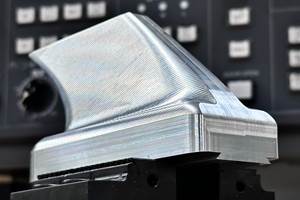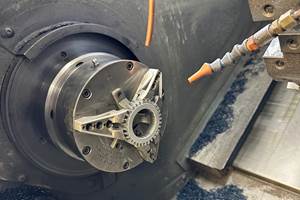Single System Offers Multiple Finishing Processes For Small Parts
An electrochemical finishing technology geared toward small workpieces cleans, deburrs, passivates, polishes and stress relieves workpieces all at once.
Share






Accurate machining is only one piece of the manufacturing puzzle. Machined components, especially those used for medical, scientific, semi-conductor and automotive applications, often require secondary finishing processes for polishing or burr removal before assembly or use. These secondary operations can be challenging for very small parts or parts with delicate features. Mechanical finishing processes have the potential to be damaging, while conventional electropolishing (EP) may not have the capability to remove large burrs. This is often why many shops will outsource this post-machining work.
Extrude Hone (Irwin, Pennsylvania), has developed a new electrochemical finishing technology that can perform five finishing processes in one operation. Geared toward small-parts finishing, the companyŌĆÖs CoolPulse system simultaneously cleans, deburrs, passivates, polishes and stress relieves workpieces. The non-contact system will not damage tiny features, such as thin walls. It offers advantages over traditional EP in that it uses a cool, non-fuming electrolyte solution that is easy to handle. Plus, the systemŌĆÖs relatively small learning curve may lead shops to consider bringing finishing work in-house, where they can have better control over delivery time, part handling and costs.
Like conventional EP, the CoolPulse process immerses workpieces in an electrolyte bath and applies a low-voltage DC charge. However, the CoolPulse process differs from EP in various ways, according to Jim Koroskenyi, managing director of Extrude HoneŌĆÖs electrochemical business unit. It uses a chilled, high-resistance electrolyte solution with a near-neutral pH level. Because the solution is odorless and non-fuming, it does not require a dedicated ventilation system and is safe to handle. Its high electrical resistance makes it effective for removing burrs and peaks on workpiece surfaces. A filtration system allows the solution to retain its effectiveness over extended periods of operating time, eliminating costs for additional solution or for waste disposal.
The solution is compatible with a variety of materials, including steels, aluminum and magnesium, as well as chrome and cobalt alloys and copper-based alloys. The system accommodates different material types and workpiece sizes through adjustment of parameters such as voltage, pulse, time and temperature. Typical finishing cycle time ranges from 15 seconds for very small parts to 3 minutes for workpieces with large burrs and heavy polishing requirements. Those cycle times are the same for one or multiple parts. This is twice the speed of conventional EP, according to Mr. Koroskenyi.
While CoolPulse is optimized for burr removal, substantial surface and cleanliness improvements are natural by-products of the process. The system produces a mirror-like finish on stainless steel and bright to matte finishes on aluminum.
Mr. Koroskenyi says conventional EP can take considerable training and experience to maintain process control, which is often why shops outsource this these secondary operations. However, this works against the goal of single-part manufacturing, cellular production and minimizing part movement. The CoolPulse system is designed for installation on the shop floor, and the skill set needed to operate the system is said to be comparable to that required to operate a CNC machining center or EDM unit.
So what kind of learning curve would shops having no experience with such finishing equipment face with this system? Mr. Koroskenyi says that shops should first spend two days of theory training and three days of practical demonstration and tooling and process training. After two to three weeks, shops should be able to master the technology for one class of parts. Two to three months later, shops are likely to possess sufficient understanding to finish virtually any type of part.
Related Content
Custom Workholding Principles to Live By
Workholding solutions can take on infinite forms and all would be correct to some degree. Follow these tips to help optimize custom workholding solutions.
Read MoreLean Approach to Automated Machine Tending Delivers Quicker Paths to Success
Almost any shop can automate at least some of its production, even in low-volume, high-mix applications. The key to getting started is finding the simplest solutions that fit your requirements. It helps to work with an automation partner that understands your needs.
Read MoreChuck Jaws Achieve 77% Weight Reduction Through 3D Printing
Alpha Precision Group (APG) has developed an innovative workholding design for faster spindle speeds through sinter-based additive manufacturing.
Read MoreShoulder Milling Cuts Racing Part's Cycle Time By Over 50%
Pairing a shoulder mill with a five-axis machine has cut costs and cycle times for one of TTI Machine’s parts, enabling it to support a niche racing community.
Read MoreRead Next
Machine Shop MBA
Making Chips and 91▒¼┴Ž═° are teaming up for a new podcast series called Machine Shop MBA—designed to help manufacturers measure their success against the industry’s best. Through the lens of the 91▒¼┴Ž═° benchmarking program, the series explores the KPIs that set high-performing shops apart, from machine utilization and first-pass yield to employee engagement and revenue per employee.
Read MoreAMRs Are Moving Into Manufacturing: 4 Considerations for Implementation
AMRs can provide a flexible, easy-to-use automation platform so long as manufacturers choose a suitable task and prepare their facilities.
Read More




















